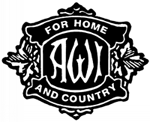Role and Function of AWI Branches
The Alberta Women’s Institutes (AWI) is organized at four levels: the provincial, district, constituency, and branch. The “Women’s Institutes Act 1929” (The Act) sets out guidelines for forming and operating branches. All branches incorporated under The Act are required to include in their name, the words, “Women’s Institutes.”
If several branches were located in the same vicinity, members became creative in naming their branch. For instance, several branches were located in the Millet area: Millet (named after the village), Tillem (Millet spelled backwards), Golden Glow and Wang (named after school districts), and Lady Tweedsmuir (named after a WI patron and wife of a former Governor General of Canada). One branch in central Alberta was named for an honoured member: Mary Riley.
According to the Act, section 10, “eight or more women, married or single, over the age of 16 years, residents in the same vicinity, and not members of any other Institute may proceed to the formation and incorporation of an Institute….”
At the height of the organization’s operation between 1940 and 1965, the Alberta Women’s Institutes had more than 350 branches located across the province. By the early twenty-first century, these numbers had dwindled to approximately 50 branches Alberta-wide. Today, branches are relatively small, with 8-15 members; at the heyday of the organization in the 1950s, branches might have as many as 30 members.
The first AWI branch was organized by Martha Graham in 1909 in Lea Park, a small agricultural community in northeast Alberta. In organizing the Lea Park Women’s Institute, Mrs. Graham relied on her own experience with the WI in Ontario. Indeed, many of the first WI branches in Alberta owed a great deal to the personal experience of women who had emigrated to the prairies from Ontario or from the United States, where women’s clubs were a well-established and integral part of rural life.
Most WI members have confined their activities and their allegiance to the branch, which is the level where the organization holds its greatest significance for individual women, their families, and their communities. The life of the individual WI branch is, in many ways, separate from the life of the provincial organization. Although the branch members support the AWI with their dues, send members to the district and annual provincial conventions, and participate in AWI organized projects and programs, many see their “real” work as local.
In each community where they were established, the WI branches served an important role as fund-raiser for building community infrastructure. In the early years of the Province, this might involve raising money for the establishment of hospitals, community halls, cemeteries, libraries, and rest rooms for women. In the years before the Province assumed responsibility for hospitals and libraries, WI branches operated several of these facilities themselves.
The minutes of the WI branches reveal how crucial their work was for building rural infrastructure. Although the amounts of money now seem paltry, revenue raised at teas, socials, and dances amounting to hundreds and thousands of dollars meant the difference between having a local facility or nothing at all in the first two decades of the twentieth century.
Once the rural infrastructure was in place, WI branches relied on their organizational abilities to raise money for good causes, such as Red Cross and radium, treatments for cancer patients, as well as international development projects, organized by the Associated Country Women of the World (ACWW).

